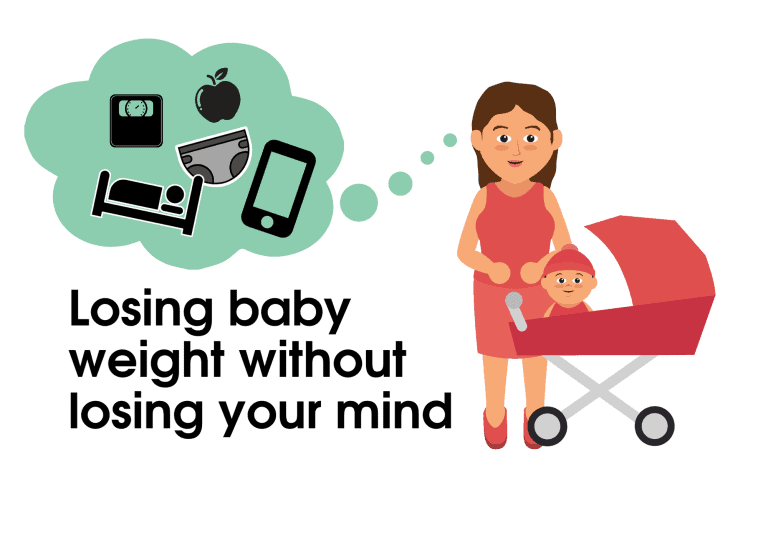There is a lot of cultural pressure to get back to your “pre-baby body” 3 seconds after blissfully pushing out a baby in a candlelit water birth. Let me be clear: I am not here to further that pressure.
However, a few months after having a kid, you might start feeling like, “I thought this weight was supposed to melt right off if [I was nursing/I started exercising again/because it did for my mom/whatever].” I get that being at a higher weight than you’re used to can feel really uncomfortable and can make you feel like a foreigner in your body. Getting back to your old weight can help you feel more like yourself again, which can help with a lot of other postpartum emotional hurdles.
While I am not pushing you to lose weight at the pace of a Hollywood celeb headed for the red carpet, I also don’t think you should feel guilty or vain for wanting to look like yourself again. You deserve to feel HOT and love the body you’re in. We can work on that emotionally, but we can also work on it physically. So, let’s get into it.
Losing Baby Weight: Diet vs. Exercise
Losing weight postpartum is tricky. Some women drop it immediately without any effort. Others work at it and see no results. Some people burn calories and lose weight easily due to breastfeeding, while others hold onto weight until they stop breastfeeding. Sometimes your body returns to “normal” when you can begin a regular cycle. Sometimes it doesn’t.
While many women think that exercise (or lack thereof) is the big reason they’re not losing weight, research has found again and again that it usually comes down to diet. That said, unless your doctor has recommended a calorie-restricted diet, you should probably forego tallying calories for at least the “fourth trimester” or the first 3 months after birth (and possibly longer if breastfeeding – again, ask your doctor!).
On the other hand, while you may not want to restrict calories, it is usually safe to begin exercising again (gently!) pretty quickly postpartum. So, you may choose to start that process, as over time, increasing your overall fitness and making progress toward being able to do vigorous, muscle-building exercise will increase your resting metabolism. If you aren’t cutting calories, this may be one thing you can control and start working on almost right away.
Why You’re Struggling to Lose Weight Postpartum
While I am not a nutritionist, I will try shed some light on a few reasons moms may struggle to lose weight postpartum or find that the way they eat or things they did in the past haven’t worked. A few things are possible, or more likely a combination of these things:
- From this pregnancy until you stop nursing, your body is going to hold onto extra weight in order to support both you and the baby.
- If you have a diastasis recti (DR), this can make you look like you have more of a belly. The separation of the abs creates a “pooch” that isn’t actually extra weight, but is just the connective tissue being stretched. So if you actually lost most or all of the weight, but just didn’t look the same, that could be why. (Talk to me, a PT, or a doctor about how to assess a DR.)
- Hormonally, pregnancy is often described as being like “a second puberty.” It can, in a sense, reset your “natural weight,” kind of the way puberty does (like, after puberty you get boobs and hips). Sometimes weight changes after pregnancy can be due to a thyroid issue; I am NOT suggesting you have one, but if you’re truly concerned, you can read more here and talk to your doctor.
- Girl, we’re just getting older. Obviously, over the 2 year prenatal/postnatal period you’re also getting two years older. If you’ve done that more than once, you’ll obviously realize that you’re a fair bit older now than before kids. Around late-20s/early-30s, lots of women start to have more trouble keeping weight off (and many women say it keeps getting harder each decade or so).
- You’re more sedentary and/or distracted after having kids. When you’re a hot young single or newlywed, there’s a fair chance you’re more active in your day-to-day life and you may just naturally eat healthier vs. when you’re home with kids and mindlessly eating the hot dogs or mac and cheese left on their plate. I doubt this alone explains it, but it’s possible you’re not as good at noticing what you’re eating or how much you’re moving because your kids are your priority.
- If you stepped down the amount of high-intensity training you were doing during pregnancy compared to pre-pregnancy (which I recommend!), the potential muscle loss will decrease your resting metabolism.
Most likely, it’s some combination of all of those things.
What Can You Do?
Again, the answer is not to jump on a highly restrictive diet and starve yourself thin. Think of postpartum as an amazing opportunity to gently explore what your body actually wants to eat. Notice if you’re eating emotionally or out of boredom – sometimes the added time at home and/or stuck under a sleeping or eating newborn can cause that distracted eating.
But other than that, while exercise alone will NOT make you lose weight, it is a healthy step you can take in the right direction. Learn more about postpartum exercise here, join postnatal yoga here, or book a free wellness consult with me here.

